#hashtag extreme empathy problems
Text
W5: Digital Citizenship and Political Engagement

Digital citizens refer to individuals or groups who utilize digital technology for the purpose of engaging in networked participatory behaviours (Lu et al. 2023). It involves four interconnected elements: individual, policy, political, and social participation (Lu et al. 2023). Digital citizens imply equality in transmitting and receiving knowledge (Jessenia et al. 2020), regardless of factors that might cause exclusion such as gender, age, and social and economic status. Digital citizenship is briefly defined as the norms of responsible behaviour considering the use of technology by digital citizens such as ethical awareness, empathy, and responsibility (Mossberger, Tolbert & McNeal 2007). But nowadays, digital citizenship has evolved into a form of online engagement and participation through appropriate communication and decision-making processes (M Jones & J Mitchell 2016). One of the characteristics of digital citizenship is the high level of activity in responding to public issues by citizens, especially through social media (Mulyono et al. 2023). The citizen’s participation in public issues refers to the term “engagement” which is understood to include social capital, civic engagement, and political participation (Skoric et al. 2016). Social media therefore serves as a key tool to boost citizen engagement through communication, discussion, and the coordination of public and social activities (Warren, Sulaiman & Jaafar 2014).

Twitter exemplifies a powerful platform for citizen engagement and political communication tools (Campos-Domínguez 2017). Research suggests its potential to increase voter engagement, as evidenced in the 2010 UK elections, the 2012 US presidential elections, and the 2013 Italian elections (Murthy 2015). Notably, the 2012 US elections saw Twitter abuzz with hashtags like #gop, #gop2012, and #republicanprimary, demonstrating its role in shaping public discourse.
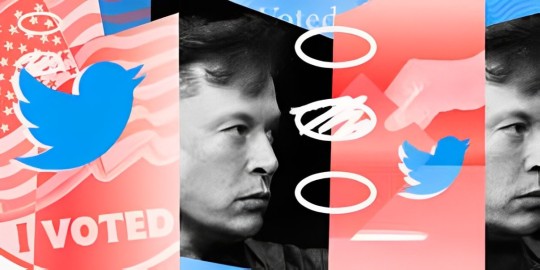
While Twitter serves as a valuable tool for political campaigns, debates, crowdsourcing, and information verification, it also presents challenges. Its speed, immediacy, and hashtag-driven nature can facilitate the spread of misinformation, rumours, and even verbal violence(Oh, Eom & Rao 2015). Research suggests its potential for opinion-building, democratic development, and even limited media freedom in regions where voting rights are restricted. However, the 2016 US election saw Twitter potentially contribute to decreased approval ratings for Trump, possibly due to a "backlash" effect from moderate voters against his unique Twitter behavior (Bursztyn, Egorov & Fiorin 2020). Trump's prolific tweeting differed from other candidates in tone, content, and hashtag usage. Notably, his tweets often included disinformation and distrustful narratives. His signature #MAGA hashtag fostered a community of followers who readily spread his messages, further amplified by media coverage, creating a self-reinforcing cycle.
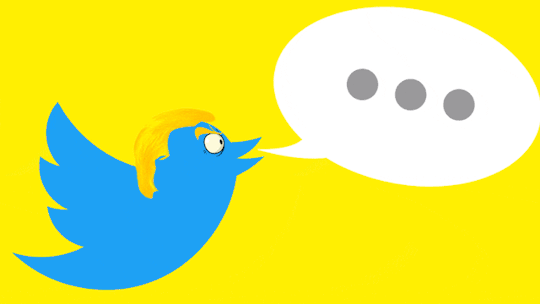
Reference list
Bursztyn, L, Egorov, G & Fiorin, S 2020, ‘From Extreme to Mainstream: the Erosion of Social Norms’, American Economic Review, vol. 110, no. 11, pp. 3522–3548.
Campos-Domínguez, E 2017, ‘Twitter Y La Comunicación Política’, El Profesional De La Información, vol. 26, no. 5, p. 785.
Jessenia, N, Dalila, V, Barredo Ibáñez, D & Pérez Lagos, C 2020, ‘Digital Citizenship and Participation through Twitter: the Case of Provincial Capital Municipalities in Ecuador (2009–2019)’, Advances in Intelligent Systems and Computing, pp. 681–692.
Lu, H, Fu, K, Liu, X & Hu, W 2023, ‘Digital Citizen Participation of College students: Reality and Optimization Path’, Problems of Education in the 21st Century, vol. 81, no. 2, pp. 244–257.
M Jones, L & J Mitchell, K 2016, ‘Defining and Measuring Youth Digital Citizenship’, New Media & Society, vol. 18, no. 9, pp. 2063–2079.
Mossberger, K, Tolbert, CJ & McNeal, RS 2007, Digital Citizenship, The MIT Press.
Mulyono, B, Affandi, I, Suryadi, K & Darmawan, C 2023, ‘Online Civic Engagement through Social media: an Analysis of Twitter Big Data’, Jurnal Cakrawala Pendidikan, vol. 42, no. 1.
Murthy, D 2015, ‘Twitter and elections: Are tweets, predictive, reactive, or a Form of buzz?’, Information, Communication & Society, vol. 18, no. 7, pp. 816–831.
Oh, O, Eom, C & Rao, HR 2015, ‘Research Note—Role of Social Media in Social Change: an Analysis of Collective Sense Making during the 2011 Egypt Revolution’, Information Systems Research, vol. 26, no. 1, pp. 210–223.
Skoric, MM, Zhu, Q, Goh, D & Pang, N 2016, ‘Social Media and Citizen engagement: a meta-analytic Review’, New Media & Society, vol. 18, no. 9, pp. 1817–1839.
Warren, AM, Sulaiman, A & Jaafar, NI 2014, ‘Social Media Effects on Fostering Online Civic Engagement and Building Citizen Trust and Trust in Institutions’, Government Information Quarterly, vol. 31, no. 2, pp. 291–301.
0 notes
Text
Philosophers on Hate

Rich Spiegel
HATE is becoming America's top national value and preoccupation. Details aren't necessary, but since the opposite of hate is love and the opposite of love is apathy, it's possible that engineers like Musk don't really know what ethics is, or think it's just a nuisance in their journey to fetch more money through more inventions--including those that alter "human" beings.
Where is Mary Shelley when we really need her?
Musk knows GAI but not ethics, and the twain haven't met yet. Also, mutual ignorance about others' expertise will not help the AI crises ahead. Musk also seems clueless about anti-Semitism, what it can do, including mass murder.
Or he simply doesn't care who or what opens an X account as long as the numbers go up. This lack of understanding or respecting human emotions will further alienate human reasoning from basic values, like preventing the destruction of his own society and projects.
Controlling human brains, Musk's current secret project--the GAI would communicate with receptor patches in the brain--is unethical because it's bound to reduce or eliminate the choices a human naturally has when making big decisions, like getting married or launching an H-bomb.
Denying that is to deny also denies any "free will" by humans.
Musk's AI to brain? "Here's the proof that Russia is about to launch missiles at the US...." Brain back to AI sender: "Let's send billions of warning messages to all Americans and then send 'Attack!' commands to all our military leaders."
Reason alone skips life's values or stands in their way. GAI will do that.
Theoretically the most important project now is not merely the development of advanced AI--it's to program in it, IF possible, some extremely basic ethical values (e.g. preserving life) that most people can agree on.
Longest-term problem that could stop or undermine GAI? It operates by supposedly neutral facts, not values that could, for instance, help bring Americans back together. But as Hume said, no amount of facts can determine values (Is vs. Ought).
Finding values from facts has not only not been done--Hume would tell us it can logically never be done.
Add to the above: no amount or kind of reasoning can jump over Nietzsche's chasm of morality--and the more you use and emphasize reasoning ability alone, the farther you get away from practicing ethics. Adopting facts is easy; values, not so much.
No action results directly from any reasoning, Hume holds; human action comes from our passions, including empathy--"feeling with" others as they're feeling it--and the new AI can't acquire passions.
Hume used the word "sympathy" because "empathy" wasn't invented until the late 19th century. With empathy you feel what others feel, as they feel it. That allows personal emotional involvement leading to ethics.
Empathy is not pity--it just allows different people to feel the same way. Judgments of right and wrong are then appropriate.
No passions means no ethical judgments or feelings, and no ethics means no resulting actions, just the facts, which only lead to more facts; not to the deep emotions people feel (pro or con) about the facts, much less to act on their feelings.
Nietzsche blames that void on Nihilism, the lack of all values.
hashtag#Hate hashtag#Emotions hashtag#Hume hashtag#Nietzsche
0 notes
Photo

when you create the right emotional atmosphere to work on a project~
but then you’re emotional.
*cry*
19 notes
·
View notes
Note
as a black fall out boy fan, i’d like to know if you think that patrick has changed his views on police since his incident in 2014. i feel like fall out boy stans never really talk about it and i’d like to know how you feel
tldr: since he surrounds himself with very left leaning people and twitter is Like That i think he just didnt want to say acab on twitter and deal with centrist/republican fall out boy fans. he shouldve though ngl
youre right, people dont talk about it enough. if im being perfectly frank, i think that exchange deserves the benefit of the doubt, at least a little bit, because of being had on twitter and the people patrick surrounds himself with. my immediate interpretation of what he said was more akin to "i empathize with the fact policing is a dangerous and difficult job, but its not an excuse" with the latter half not being something clearly stated but kind of implied. thats like, the core of acab. all cops are bastards not because each individual cop is a bastard but because the job description of a cop is bastard activity. you should be able to empathize with cops cuz thats a human person, but you shouldnt ever stop holding them accountable.
and especially since patricks a v empathy first kind of person, plus the fact he specifically is very in the public eye, like, 50% of the face of fall out boy, it wouldnt surprise me if he was either equivocating to not get in trouble with their management, (because theyve never really been on great terms with their label) and/or trying to explain that you shouldnt dehumanize people even when they do bad things (because you shouldnt and it makes it harder to recognize problems in people you agree with). that said his wording was very "not all cops"-y and unless he like, clarifies that hes definitely in favour of police abolition i dont fault anyone for being wary, because the nature of the way he said it meant he explicitly would not seem outright opposed to policing.
that being said, if he was at some point not fully sold on police abolition or at LEAST reform, i doubt andy hurley would let that slide for very long. in fact i doubt ANYONE in fall out boy would let it slide for very long. their politics dont often come up in many interviews but at several points in smaller interviews or personal projects pete, joe, and andy have been vocally very left leaning. hell patrick has his moments too! thats why im willing to give him the benefit of the doubt in terms of this exchange.
considering that theyre all like, genuinely best friends, and like even their guitar tech and photographer and hey chris all post some pretty radical stuff on their stories (all folks they are Also on good terms with with), it really seems to me that its more that he cant get away with saying radical stuff like andy or joe can, and is not willing to cause a scene like pete sometimes is, and saying acab on twitter in front of all his followers might rock the boat in a way that makes it harder to sneak people on it in the future.
this isnt to say he didnt do anything wrong, i think this was a situation in which saying the right thing with your whole chest wouldve been ideal, and again, i really cannot fault anyone for feeling like it was very hashtags not all cops, because unfortunately the conversation of "racists are people just like us and we shouldnt forget that when we are confronted with consequences of our bad actions" looks very similar to "racists are people just like us which means we shouldnt make them deal with the consequences of their bad actions" especially since the former is Extremely Rare in the wild.
sorry this is long ive done a lot of thinking about this but i genuinely feel as though in terms of actions hes not a not all cops kind of dude
#dils declares#i have genuinely been thinking about this since he tweeted that. i did see it.#also did he delete those tweets. idr and im not opening twitter to check.
14 notes
·
View notes
Note
Bee, what that person said on anon was not only cowardly to do on anon, but also just plain wrong. I normally post as anon because of some social anxiety I have but I have no problem being off anon for this: you are the first blog I've ever followed and in that almost-year (end of the month!) you have shown to be an extremely intelligent, warm, compassionate, nonjudgemental, talented, hilarious person. When I first saw you hadn't posted in a few days, my first thought was that I hoped (1/2)
that everything was okay with you, not that you were "staying silent" or anything absurd like that. I hope everything works out with your health issues. You deserve health and happiness and peace. I hope you find that and return to writing for this blog when its good and convenient for you as I know there are lots of people here who support you and appreciate your writing for the escape and entertainment it provides us in a world that is very hard sometimes, especially right now. (2/2)
_____
Thank you for coming off anon to message me! And thank you for following me for so long!! I really appreciate your very kind sentiments.💜
The problem I am seeing all over our fandom and all over news and all over social media is that people want there to be easy answers. People want to say that it’s just a few bad cops and ignore the systemic discrimination in our policing and justice system. People want to say all cops are bastards and ignore the many who care deeply about the communities they serve. People want to say don’t protest, just go vote and ignore the continued obstacles put up to prevent people of color from voting. People want to say that every one of these protests is right and ignore the harm that is done to neighborhoods by looting. People want to believe that just because you are a good person who is kind to people that you could never be part of the problem, while ignoring the power structures and privilege that they benefit from. People want to be able to sort the world into “racists” and “not-racists” based on who does or doesn’t put up a black square on Instagram while ignoring the reality that a few trending hashtags will not make meaningful change.
Every single one of those issues is so complicated and requires so much discussion. Just the way I’ve summarized them here will probably piss a bunch of people off. But discussion is hard and requires two things that seem to be in very short supply lately, especially on the internet: vulnerability and empathy.
I can be all those wonderful things you said about me and still be wrong. I can and have been ignorant. I can and have been prejudiced. I can and have been cowardly. And I am sure I am still all of those things in ways that I haven’t reconciled with myself yet. I can have the best intentions and still hurt people and sometimes I don’t have the best of intentions.
If people want to call me out for things I have or have not done, I need to be strong enough to listen to what they say, be vulnerable and admit my mistakes, and reach out with empathy as to why they may be upset or hurt.
On the other side, people who want to lash out in anger at those who are processing these events differently from them need to also find it in them to have empathy for those they are about to criticize. To be vulnerable in admitting all those things that they don’t know about whoever is on the other side of that computer screen and to view each other as whole people who are all worthy of kindness and respect.
Long term change only comes through hard work done on an individual person-to-person level and only happens when people have the willingness to both teach and learn.
42 notes
·
View notes
Text
Slavery in Thedas: How BioWare Could Bring Nuance to Dragon Age
The Electronic Entertainment Expo (E3), video gaming’s most prominent trade show, has dimmed its lights and shuttered its doors until next June. One game that was conspicuously absent was the highly anticipated fourth installment of the Dragon Age franchise from EA-owned BioWare. This isn’t so surprising since a Kotaku article detailed the turmoil going on at BioWare that led to a truly abysmal reception for its latest game: their first try at an online loot-and-shoot adventure, Anthem.
Still, I must admit that I have thought about Dragon Age every day since The Game Awards of December 2018. That’s when BioWare dropped a 65-second teaser and launched a hashtag that had me hooting triumphantly in my living room, #TheDreadWolfRises. I even wrote an article about who from the past games should appear in the next.
I have met some of my all-time favorite characters and gone on my most beloved adventures while traversing the carefully crafted world of Thedas (The Dragon Age Setting). A big part of that is due to the broader themes of how theocracy, colonization, and war affect the marginalized and enrich the powerful.
Creating worlds
of adventure, conflict and companionship
that inspire you to become the hero of your story.
The statement above is only one of the many messages on BioWare’s website that highlight how much they value story and characters in their games. This attitude has served BioWare well. Its last unqualified success, single player RPG Dragon Age Inquisition, earned a whopping 130 Game of the Year Awards in 2015 and had professional critics specifically praising its story.
Of course, not everyone has been impressed. BioWare frequently gets criticized by what I like to refer to as the “dude bro army” for daring to include PoVs that aren’t in lock step with the dominant culture. Read: “Y’all have too many queers, coloreds, and non-hot ladies in your games!” Back in 2011, the lead writer for the Dragon Age series at the time, David Gaider, wrote a response to one such gamer on their now-defunct message board that was so well crafted it garnered press. Gaider, an out gay man himself, challenged the notion that video games should cater to the fabled “straight male gamer” that all such close-minded dude bros evoke when complaining about diversity. As a bi Black woman gamer, this endears BioWare to me even more.
All is not perfect, however. In addition to sex and sexuality, racial oppression and hegemony are two frequently explored themes in Dragon Age games. There is an allegorical connection between the systemic and situational anti-elf sentiment found throughout Thedas and the anti-Black sentiment that runs rampant in our own world. The problem is that many of these experiences are written and crafted by folks who have never been on the receiving end of this kind of oppression. Although talent and empathy carry the stories surprisingly far, the devil is in the details.
In fact, the usual formula of giving players the freedom to choose how they want to act allows for just as much conquest, haughty disinterest in ethical decision making, and even slave profiteering as opportunities to fight those evils. (I try not to think of how many players across the globe regularly sell elves to slavers for a few in-game bucks while I’m murdering every slaver that the game will allow.)
This is why when another Kotaku article reported that a Dragon Age project set in Tevinter—the slave trade capital of Thedas—was scrapped, I didn’t share in the disappointment that bubbled throughout fandom. Quite frankly, I was relieved. I unfortunately don’t see BioWare being able to craft a story taking place in Tevinter in a way that won’t be chock full of obliviousness, microaggressions, and straight up triggers for Black players.
How can I think this way about one of my favorite game franchises of all time, you ask? Well, in Inquisition, it was not only possible, but extremely easy for someone playing as an elf to make a mistake and wipe out their entire clan while assigning missions on the war table. Because this process takes place over multiple in-game decisions and hours of gameplay, there was no way to go back and fix it. What’s more, no one even acknowledges that it happened in the game.
To be fair, the developers admitted that this was a problem, but saw it more as a design faux pas akin to other similar war table missions that went awry. To me, it resounded particularly loud to see an oppressed people who were frequently set upon by aggressive humans get extinguished like a flame all due to my actions. What’s more is that this is my Inquisitor’s family and the only society she’d known until the beginning of the game. To say it jettisoned me out of the heroic role play fantasy for a while would be an understatement.
Later in the “Jaws of Hakkon” mission, when it is revealed the first Inquisitor was also an elf but the chantry (church) scrubbed all records of this from history, the game similarly ignores the profound implications this would have for an elven Inquisitor. I have spent my whole adult life trying to sankofa (go back and fetch) all the history of my people that has been deliberately obscured or warped by a western school system. This connected to my life in a way that was never even partially explored in the game.
Other ways a few high ranking Black developers could have helped BioWare is with Dorian. Sure, he’s one of their most dynamic, fun, and charismatic characters in Inquisition. But he’s also an unrepentant slave owner who, even late in the game, vacillates between vacuously apologizing to Solas for Tevinter’s fabled domination of Elvhenan and encouraging the annoyed elf to enslave spirits to do his bidding.
And then there’s Vivienne, the one character designed as a Black woman. Look, I’m not suggesting that tough as nails, power enthusiast Vivienne should’ve dropped her unfriendly Black hottie status and held hands with everyone. But how much more nuanced and mindful would Vivienne’s characterization have been in the hands of a Black woman who has spent her academic and professional career modulating her voice and carefully curating her demeanor to avoid the scarlet letter of being dubbed “angry” or “difficult”? What made “The Iron Lady” into the cold, calculated defender of the status quo? The horrors and indignities she must have faced in the Ostwick Mage Circle that led her to create her impregnable persona are never even hinted at.
Furthermore, Vivienne is immediately and permanently pit against the most lovable character in the game, Cole. No one in the game seems to understand her position. She is a Circle mage that was taught to mistrust and fear demons before she was able to read. Of course she’s scared to death of Cole! Instead, the game just casts her as an irrational bigot and a danger to ‘innocent’ Cole, a being that even admits he is potentially quite dangerous.
And that's not to mention Sera's internalized elven racism and self-hatred that could have used more nuanced handling from someone of a community that deals with such things.
I just…Hire some Black writers and developers, BioWare.
That way when you explore these themes common to our experience there will be a level of authenticity Black players can appreciate and identify with immediately while non-Black players get to enjoy a narrative shaped by people with a deeper connection to the subject matter. Having multiple queer writers helped the sexuality content immensely; it’s time to do the same for the racial commentary.
Patrick Weekes, the current lead writer for the Dragon Age series is an immense talent. He wrote my favorite character in the entire franchise, The Iron Bull, and two others in my top 10, Cole and Solas. I have no doubt that he and his team will create an incredible yarn, but if BioWare wants to level up and reclaim their former glory after their last few games have struggled, leaving their brand a bit tarnished, they are going to have to evolve and invest in more diverse, authentic voices.
114 notes
·
View notes
Text
We need social media to be biased towards rational arguments, ASAP.
If you want to know what a controversy is about on twitter clicking the hashtag is one of the least helpful things one can do, is usually filled with insults from people with 2 points of view attacking each other, just people rambling with negative adjectives towards each other and little to nothing about the facts surrounding the subject at hand; but 100% of the time there is someone who can eloquently point out the arguments for one point of view, and another person with an equivalent eloquent version of the opposite point of view, but finding any of those 2 people in a hashtag search results is like looking for a needle in a haystack; when sorted by popularity the tweets at the top are NOT the most likely to convey all the information but the ones that drive the biggest emotional response or the ones that draw in the biggest empathy from people that already hold that very same point of view.

Some people believe this problem is hopeless and there is no way to solve it, that this is how human race behaves and we are just seeing that behavior on a scale never seen before thanks to the internet... but I don't fully agree, the lowest hanging fruit that no major social network is even trying to do is limiting the number of posts an user can make, perhaps a limit of 3 per day or something reasonable; next lowest hanging fruit is making some super-basic intelligence check, I'm not talking about any controversial questions, I'm talking about 2 + 2 level stuff, even controversial subjects have questions you can ask without supporting either side, for example if someone is making a tweet about GMOs they should know that it stands for "Genetically Modified Organisms" regardless of being in favor or against those, and the outcome of the answers shouldn't be blocking someone from posting or allowing them to do so, but more like a multiplier of the reach their post will get on the platform, in other words how likely it is that it will be shown on other peoples feeds and searches.
Of course for the existing social networks making themselves more rational would be a financial negative, Facebook and Twitter can show the most monthly activity to shareholders thanks to extremely passionate people holding completely opposite points of view, those people are the ones that watch more ads, click more links and are the ones that keep comment threads alive -specially when they can make other people behave the same-, thanks to such feedback-loop is counterproductive for them to limit the number of daily posts each user can make, they care a lot more about making money from society than about its mental health or about its decay, in other words noise is an financial asset for social networks and a harmful presence for society.
And that's the one point that we need to take a stand on, just like some people are standing against companies damaging non-renewable natural resources for profit gains (AKA "generate greater shareholder value") we need to stand against companies doing severe damage to social dynamics and therefore the politics of every country in the world where they are a main channel of communication.
1 note
·
View note
Text
Secret Garden
I know, I know, it's an assignment book, but I will still include it in my reading log, and I do this because while reading this I had all sorts of questions. So let us dive into our small Q&A session
Q.#1 Why does the author dislike Mary so much?!
It is not really hard to figure out that the author hates Mary at least at the beginning. This poor girl has ALL the qualities to be disliked and even hated by the reader. Almost at the beginning of the book, we get a pretty explicit description of Mary:
So when she was a sickly, fretful, ugly little baby she was kept out of the way, and when she became a sickly, fretful, toddling thing she was kept out of the way also. [1, p. 2]
It seems like the author doesn't miss any chance he gets to accentuate how ugly and disgusting she is in every way possible. She has no manners, she hits people, she waits for everybody to do everything for her and doesn't even think to say please or thank you. Nobody really likes her, and the author seems to coerce the reader to despise her, but I rejected that position. Why do I have to hate the poor girls, who got half-raised by Indian servants and never truly belonged to anybody? Why do I have to hate Mary for her lack of obedience and manners if she has never been taught how to behave?
I don't think I have an answer, although there is an assumption. The book was written in 1911, and at that time, the didactic influence on children's literature remained relatively strong. Deborah Stevenson, in her article "History of Children's and Young Adult Literature" states:
Didacticism remains a strong element of contemporary children's books ostensibly designed for pleasure.[2, p. 180]
So there we have it, Mary is designed to be disgusting at the beginning of the book because children who do not behave cannot be good. They have to take a spiritual journey, understand how to be a good member of society, stop being disagreeable. Only then they can be worthy of pleasing adjectives.
Interestingly enough, Marina Nikolajeva in her article “Did you Feel as if you Hated People?” states, that Mary is depicted in that way, because the author doesn’t want readers to relate to characters, to merge with their personality.
The “just-like-me” assessment of characters, frequently adopted by novice readers, is restricted by the readers’ experience and does not foster empathy [3, p. 101]
Nevertheless, the author admits that most of Marry's problems are a consequence of the complete absence of her family:
If she had been an affectionate child, who had been used to being loved, she would have broken her heart, but even though she was "Mistress Mary Quite Contrary" she was desolate, and the bright-breasted little bird brought a look into her sour little face which was almost a smile. [1, p. 23]
In this context, the word "desolate" caught my attention. Having looked at the Online Cambridge Dictionary, I discovered the meaning - "extremely sad and feeling alone".
So Mary is not "ugly", she is not "quite contrary", not "fretful". She is just desolate and unjustly deprived of the basic human need - the need of a family, the need for being loved and cared for.
Q.#2 Is Colin really different from Marry?
Well, no.
That would be the simple answer and the most evident one, as the author tells us more than once, that Colin and Marry are equal in how horribly they behave towards other people. Nevertheless, while reading, I couldn't help but notice how different author makes us feel about them.
Colin, who is another unfortunate child without a proper family, never gets to be called something as ugly or fretful. He is shown to be pretty egoistic, but from the author's perspective, it doesn't look like he needs to go on a spiritual journey to become "a good child". Moreover, not only once is he described as a beautiful boy, even though he often has tantrums and never goes outside.
He was a very proud boy. He lay thinking for a while, and then Mary saw his beautiful smile begin and gradually change his whole face. [1, p.129]
Now, maybe he is portrayed like that because most of the time, we see the world from Marry's perspective, and she evidently fancies him. That is why, despite him being a "brat", he has a beautiful appearance.
Q.#3 Is the book really racist?
Well, yes.
Although, that answer, just like the previous one, would be the shallow one. Let us dig deeper.
As I already mentioned, we see the world from Marry’s perspective, except only for two last chapters, where we see robin’s and Mr Craven points of view. She is the one who encountered Indian people, and she is ultimately the only source of information about India that all the other characters possess. So, being a spoiled little girl as she is, is it any wonder that she talks about Indian servants in such a humiliating way? I bet she would speak like that about any person who served her, no matter the race or nationality. There was also an interesting dialogue between Martha and Marry:
“Eh! I can see it’s different,” she answered almost sympathetically. “I dare say it’s because there’s such a lot o’ blacks there instead o’ respectable white people. When I heard you was comin’ from India I thought you was a black too.”
Mary sat up in bed furious.
“What!” she said. “What! You thought I was a native. You—you daughter of a pig!”
Martha stared and looked hot.
“Who are you callin’ names?” she said. “You needn’t be so vexed. That’s not th’ way for a young lady to talk. I’ve nothin’ against th’ blacks. When you read about ’em in tracts they’re always very religious. You always read as a black’s a man an’ a brother. I’ve never seen a black an’ I was fair pleased to think I was goin’ to see one close. [1, p. 15]
From this passage, we can see that Martha has nothing against black people. In fact, the notion of “respectable white people” comes out of her lack of proper education and the absence of intercultural communication.
In the world 21st century, it is tough to say something without enraging certain people. I dare say, the silencing imposed on the Internet speech came to the point, that you are afraid to state your opinion without being condemned (Twitter campaign with hashtags RIPJKRowling as the most recent example).
The same thing applies to the books such as Secret Garden that cannot fit into modern cannon. Should we ban them? Where is the line between book propagandising the racism and the book that has racist characters in? Should we simply deny the existence of such people? And if yes, wouldn’t this denial be more dangerous than just putting the reality of the world out there for children to see? How do we insert that kind of people into a book and at the same time show that what they say isn’t quite right?
These questions are not part of our Q&A session, because, sadly, I don’t have the answer. I doubt that anyone does.
Q.#4 Why would author put that Yorkshire accent in the text?
That is a question that I asked myself pretty frequently. Actually, I wondered about it every time I struggled to read and understand it... so, every two pages more or less.
When I first encountered it, I instantly remember the books of Stephen King. In almost every one of his books, some people speak a southern American accent, making it hard to understand them. Reading those books, I didn’t bother wondering, what was the point of that kind of speech. Still, in the case of Secret Garden, the answer came to me quite quickly - it is actually a great author’s linguistic attempt to make the reader feel like Marry.
She comes to a place totally different from what she knew all her life, and even though people speak her language, she still struggles to understand them. It definitely helped me to relate to Mary, because, let me tell you, the Scottish accent is not an easy one to understand! So, I felt (and still sometimes feel) very awkward keeping asking people to repeat what they just said, just like Marry.
Q.#5 Is “The Secret Garden” anti-feminist?
It is not that hard to see, that "The Secret Garden", although started as an Entwicklungsroman, where the main character is supposed to develop and mentally mature, suddenly lost its point. The focus just shifted to Colin, and Mary was not even at the end of the story, discarded as a redundant character. While it may be seen so, there is an interesting article by Linda Parsons "' Otherways' into the Garden Re-visioning the Feminine in the Secret Garden" [4] where she argues that this novel is feminist in its core. Therefore, the author points out the fluidity of the gender depicted in the book. She gives an example of Ben Weatherstaff and Dickson, who are both caring and close to nature, something that is considered to be feminine qualities.
Also, she argues that the shift of the focus from Marry to Colin is justified. From her perspective, the author's intent to show that Collin is expelled from the Garden. Therefore, it is still Marry's story, because she matured and grew as a person, while Colin, even though healed physically, couldn't reach her emotional level, so he has no place in the Garden. I accept her interpretation, although I would point out, that I can't entirely agree with her last statement "I rejoice that Mary remains forever in the garden" [4, p. 267]. The fairytale-like endings that include nouns such as forever cannot be perceived as positive. The characters should evolve, both mentally and physically, but staying in one place forever would prevent Mary from doing that.
So at first, it was tough to understand Martha and Dickson, but with time it became more comfortable for Marry as well as for me. She even started speaking in Yorkshire sometimes, and that is a way of the author to show us one of the small but significant changes in Marry. Not only she becomes more kind towards other people, she genuinely wants to learn how to speak their language. Even Colin starts to master it, I guess, this skill he acquires after his magic ritual.
Interestingly enough, in the retold version, characters don’t speak Yorkshire anymore. I think although it makes it easier for children to read it, the book itself loses a valuable lesson of acceptance of other cultures and the assimilation. I would even argue that it’s one of the most important ones, as in our age of globalisation being acceptant of different cultures is a vital skill.
___
References:
1. Frances Hodgson Burnett “The Secret Garden”, The Project Gutenberg, accessed on: 07 Oct 2020: http://www.gutenberg.org/files/113/113-h/113-h.htm
2. Deborah Stevenson. 19 Oct 2010, History of Children’s and Young Adult Literature from: Handbook of Research on Children’s and Young Adult Literature Routledge, accessed on: 12 Oct 2020: https://www.routledgehandbooks.com/doi/10.4324/9780203843543.ch13
3. Maria Nikolajeva (2013) “Did you Feel as if you Hated People?”: Emotional Literacy Through Fiction, New Review of Children's Literature and Librarianship, 95-107 pp.
4. Linda Parsons “’Otherways’ into the Garden Re-visioning the Feminine in the Secret Garden”, Children’s Literature in Education, Vol. 33, No. 4, December 2002, 247-268 pp.
0 notes
Text
#NoWallsButBridges Campaign White Paper Report on Migrant Sustainable Integration
“A grass root Public Policy International Awareness campaign”
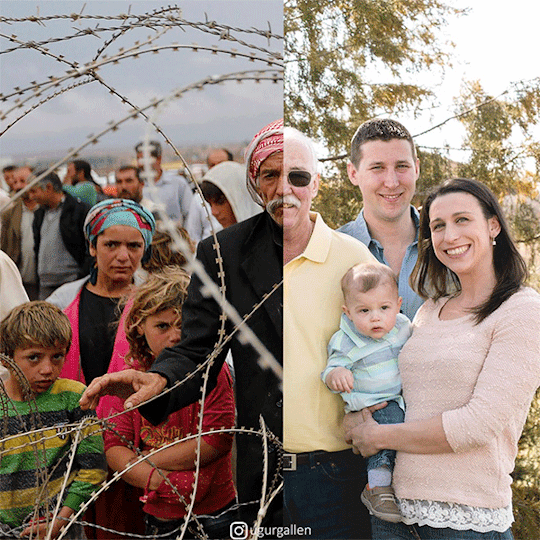
B1-AKT //Migrant Integration Lab within the context of its global awareness campaign initiatives inspired by the Global Goals for Sustainable Development launched a grass root Public Policy/Citizens Diplomacy International awareness campaign, an open social media dialogue concerning migrant solutions for sustainable integration developed in the Migrant Integration Lab device (a global device for sustainable integration).
B1-AKT a collective of deep thinkers and thought sustainable leaders teamed up with Ecole des Ponts Business School and their full MBA young leaders. The campaign was designed under the shape of a social impact project (SIP) and tailored as to build Positive & Sustainable Social Impact.
École des Ponts Business School’s Full Time MBA is a flagship program for Innovation Management in a global economy. The program leverages the latest research and traditions of excellence in Innovation, Technology Management and Entrepreneurship.
The name of the campaign was “No Walls but Bridges”. The project had a predefined budget of absolute zero. This parameter applied to the planning and execution of all deliverables, assessment criteria, and control satisfactory factors (CSFs). All participants had to use social engineering and sustainable innovation in order to achieve strategic objectives.
The campaign aimed at:
Acknowledge the benefits of immigration by crafting a positive, new narrative on integration: Developing sustainable communities and intercultural dialogue
Crafting a positive narrative on migration based on social, cultural and economical benefits deriving from it.
Inspire political engagement and active citizenship by bringing together, citizens, civic societies, migrants and refugees, public & private sector, international organizations, Academia and media around the globe into a dialogue on the problems and sustainable solutions on Migration Crisis developed in “Migrant Integration Lab”.
Building social impact
The project also aimed to identify the impacts of government migration policy and communication, and the interaction with public debate and activism. One of the project’s targets was encourage opinion leaders and political ones to act for a sustainable process of integration.
We truly believe that addressing the socio-economic development of local communities, providing sustainable solutions and training paths conducive to effective entrepreneurial projects or employment creates an environment that offers real possibilities for both receiving communities and migrants.
Project Strategic Context: Migration crisis / The rise of extremism and populism
Negative public attitude towards migration and migrant related issue, the rise of extremism and populism as well as political disengagement regarding the migration crisis can lead to public antagonism towards migration. These negative views risk jeopardizing efforts to adapt migration policies to the new economic and demographic challenges facing many countries.

Photo credit @ugurgallen
Strategic Needs:
Implementing sustainable solutions for migrants’ holistic integration.
Implementing transnational frameworks that are giving policymakers a new lens with which to develop innovative public programs, and public-private partnerships across borders.
The implementation of sustainable solutions regarding migration issues demand an international vision and a transnational framework of collaboration.
The challenges are not only economic but also cultural. The public must be encouraged to understand that newcomers also bring fresh demand and so spur growth. Such an exercise requires determination and vision, good arguments backed by facts, and much better communication. Integration requires a ‘ whole of society’ approach.
Migrants swell the workforce and help to expand the overall economy, but it’s a message that has gained little traction with public opinion. It is up to governments and civil society leaders to hammer home this message.

Vision: Migration is a chance for our societies to reach their full potential.
Transformational and systemic change starts with a compelling idea that can transform a community by engaging and empowering community members. Change also requires the active participation of institutions and policymakers.
The world’s citizens are inhabiting and tracing pathways across a globe that is in accelerated motion –ideas, things, people are all in endless movement. Sometimes they are willing adventurers and explorers but all too often people and families are displaced by turmoil, aggression and environmental disasters.
Migration is a chance for our societies to reach their full potential. Displaced people who arrive in Europe can become innovating entrepreneurs, change makers in a position to act, create value and to be a source of innovation for host societies. Our campaign was based on transnational frameworks that are giving policymakers a new lens with which to develop innovative public programs, and public-private partnerships across borders.
Our society’s response to the movement of people has often been lacking in compassion. Hope for a better future has sometimes been replaced by despair. Open doors have sometimes been harshly closed. To try and address this imbalance, “NoWallsButBridges Campaign” was born. It supports the daring idea to build societies with greater equality, sustainability and solidarity.

Values
Diversity enriches every society and contributes to social cohesion — something that is all too often taken for granted. Societies with large migrant populations are in many ways translocal and transnational themselves, already connected to many parts of the world through migrant and diasporic practices and networks.
Our work is based on the values of democracy, diversity, trust, freedom and solidarity. These values are the cornerstones of our societies and of the interdependence between countries in Europe. Underneath all of this lies the power of sustainability & communication.
Sustainability//Social Entrepreneurship // Global Citizenship//Intercultural Dialogue//Hybrid Identities //Transnationality//Common Good
The idea of the campaign was based on:
Breaking down negative stereotypes and improve public perception of migrants and ethnic minorities and the phenomenon of migration
Giving citizens the opportunity to discover, learn from and understand the values and cultures of refugees and migrants and — in the process rediscover and enrich their own.
Helping refugees and migrants socialise and express themselves, fostering respect and understanding for diversity, intercultural and civic competencies, democratic values and citizenship.
Cultivating a thriving ecosystem for social innovation and creating sustainable communities. This ecosystem, its members and the collective whole, creates more sustainable, equitable, and inclusive communities.
Implementing Sustainable Development Goals (SDGs): The 2030 Agenda for Sustainable Development recognizes migration as a core development consideration — marking the first time that migration is explicitly integrated into the global development agenda. Implementation of the SDGs provides an opportunity to protect and empower mobile populations to fulfil their development potential and benefit individuals, communities and countries around the world
The Spirit and Core philosophy of the campaign is based on Newton’s quote “We build too many walls and not enough bridges”.

Photocredit Yannick Le Guern
When we “build bridges” we are literally building a better life. When we build walls, we are stagnating our own growth and as Joseph F. Newton said, “People are lonely because they build walls instead of bridges.”
#NoWallsButBridges’s hashtag arised from both the name of Ecole des Ponts (ponts = bridges in English) and the concept of removing “boarders” and “walls”, underlining the transnational character of the campaign and enabling the articulatory process to increasingly exceed the borders of the nation-state.
One of the themes of the campaign concerning identity renewal was inspired by B1-AKT as to exemplify innovative ways to expand mutual understanding, intellectual advancement, collaborative intelligence, empathy and respect in our society.
The result
A Unique Transnational “Bridge” was built between Policy Makers, Governements, Institutions, Business schools, Civil Society members, Migrants, Refugees, Asylum Seekers, Social Entrepreneurs, Media Representatives.

Photo credit @Stamatia
The Recommendations
The implemented work, the awareness campaign and the practical results of MIL’s implementation in 7 countries leads us to make the following recommendations for turning the refugee and migrant crisis to economic, cultural and political advantage:
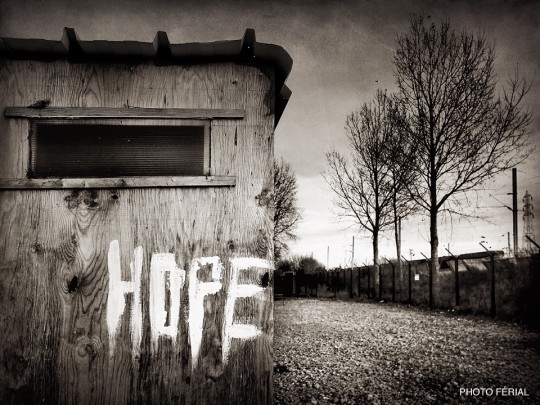
1. Change the public and politic perception on Newcomers and integration: Acknowledge the benefits of immigration by crafting a positive, new narrative on integration.
2. View Migration as a chance for Countries and Europe‘s economic growth, territory revitalization.
3. Rebuild Trust and redefine a hybrid identity: Developing sustainable communities and intercultural dialogue via social cohesion and open dialogue tools
4. Create A Global Ecosystem regrouping National and International actors, Stakeholders, Institutions working on Sustainable integration issues
5. Provide Sustainable Frameworks to strengthen communities
6. Permit rapid access to basic needs, housing and care services
7. Integrate newcomers sustainably and holistically, based on 4 simultaneous pillars via Labs:
· Linguistical thinking and communication
· Economic integration
· Civism and citizenship
· Intercultural dialogue
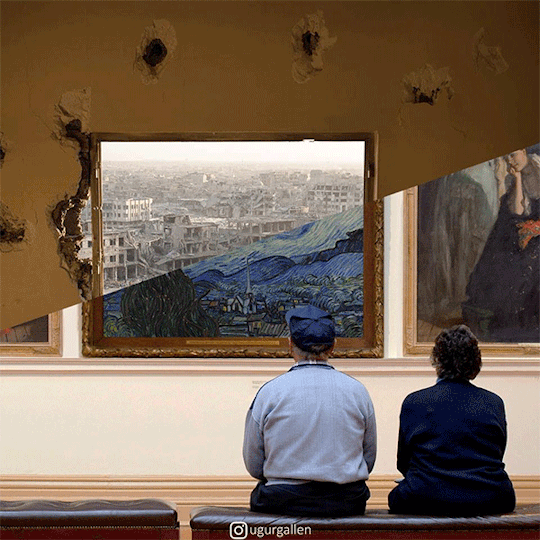
8. In order to prevent the rejection of integration policies and to combat the rise of extremism, the integration of migrants and their access to employment must not take place outside the integration of specific concerned, national groups.
9. Develop Training, Skills and Opportunities: Enhancement of social innovation and capitalizing on newcomers’ talent by strengthen entrepreneurial education and training.
10. Provide dialogic teaching, tailored services and centered learning sessions for Newcomers & vulnerable groups
11. Build economic growth and territorial revitalization via economic and entrepreneurial activities linked to territorial needs
12. Develop a daring, innovative and distinctive political vision for common and better future-build sustainable policy making based on cooperation and transnational frameworks, mainly via the creation of a 3 steps efficient & holistic process of sustainable integration:
· Step One: A global process of integration
· Step Two: A national public policy
o Professionalizing and training the main stakeholders and integration facilitators.
o Steering the integration ecosystem for a better coordination of actions & stakeholders
· Step Three: An international Network as to permit good practices exchange and enable transnational cooperation (fostering agile, adaptive and modern processes that lead to social mobility and cohesion)
13. Beyond Open Government : The Entrepreneurial State & Government. Public policies, must be renewed and include a process and an entrepreneurial approach to action, based on common and republican values.
Responding Activism and defining Transnational Citizenship
Nowadays, the representativeness and credibility of the political and leadership classes is questioned (yellow vests, black Blocks, populism). The initiatives for the evolution of our societies can only be citizens initiatives. The future of politics is a citizenship. Citizenship is the consciousness of the other, of others, of a single world and is based on a desire for common construction.
The citizenship to be created, as facing populist movements or violent destruction of our societies, requires:
The sharing of collective values that are simple to (re)discover or develop, such as that of secularism developed in France or proposed by Yuval Noah Harari, which guarantees tolerance, respect, universality, freedom and equality.
A willingness to act, to contribute to the evolution of society, to practice solidarity and brotherhood.
The implementation of concrete actions enabling everyone to carry out projects and contribute to the Society, either independently or in projects (associative, entrepreneurial, cultural, territorial, projects etc.)
The development of autonomy, responsibility, individual and collective citizenship.
The question of the integration of migrants must be raised to move to that of the construction of “our Society”. If migrants must learn to communicate, to respect citizenship, to develop civility and to integrate the values of the society in which they arrive, to achieve their integration through diligent work and projects (there are effective integration devices , cf Migrant Integration Lab), we must also find values that bring us all together, develop common projects, learn together what solidarity really means, develop our own citizenship, the willingness to act, achieve constructive criticism and autonomy.
By building this type of campaigns, improved social cohesion and wider solidarity can arise by making people work together towards a shared future trough creating strong, long-lasting basis for interaction, dialogue between migrants and members of receiving communities.
The campaign has showed that it can challenge prevailing prejudices and build bridges, against all the odds by enabling citizens, newcomers and institutions to practice collaborative ways of living together.
Key words:
Strengthening civil society
Building international networks
Moving communities
Prioritising sustainability
Social impact
The project also fostered good practice exchange and cooperation between our partners and ecosystem by strengthening their networks and transcultural skills, extends their teaching skills and knowledge on methods development and empowers their capacities in raising empathy and awareness for migrants and their realities in Europe and beyond.
Download the report on: http://b1-akt.com/nowallsbutbridges-white-paper-report-petrache-le-guern?fbclid=IwAR0r3V2H7WHLFgRrrp6DdEMRNdEMGp_Dx-DNsXUo4bgbIfSRpG-57WCqcN0
0 notes
Text
hashtag remember when. i was invited with one of my friends to hang out with another friend. neither of whom had ever had any medical training or had even self harmed!!! and was surprised when friend 1 was spontaneously! just now gonna tattoo friend 2's arm. cool cool cool cool no issue, I tat myself all the time. BUT!!! surprise twist , had to shave friend 2's arm to do it. cool cool cool cool cool sarcastically now, because I have 4+in long arm hair (ask me to take a photo for proof, never met anyone with arm hair nearly that long nor have I found a medical reason for it). extremely triggering because I've spent my entire life shamed for my arm hair, came to terms w it many years ago, but felt FUCKED UP. this friend 1 has PCOS but wasn't even considering it might be triggering to me. self harm a lot that night later on. anyways, power thru. the tat had to be touched up in a month or so (lmfao)
anyways about a month later, friend 2 asks me to look at their tat and ask if it seems ready for a touch up. I say um??? hell no, your skin's still bunching, obviously still thin, gonna tear at a moment's notice. they say something along the lines of, "well you've never done a tattoo on someone else, how would you know what scar tissue looks like?" again, I have self harmed for 8 years on and off and know a lot about medicine, I know what scar tissue looks like in its various stages of healing and I know how fragile each stage looks. (this is one of the people, also, who told me AFTER I WAS A CERTIFIED NURSE AIDE, LESS THAN TEN DAYS AFTER I HAD MY BANDAGING AND WOUND CARE COURSE RIGHT BEFORE I WAS CERTIFIED, that I was using the "wrong" type of disinfectant, isopropyl, on a VERY minor wound my cat sustained when they forced me out of my comfort zone to let my cat and their cat interact way past the level of my comfort, and they had a fight wherein my cat's ear was torn open.......this discreditization of my first aid knowledge happening about five minutes before they told me, because they work in a bakery, they NEED to be trusted on the idea that liquid and dry measuring cups are DIFFERENT and I may brook no argument to their expertise. sorry, what is my state registration as a certified nurse aide then??? working at a bakery makes you an expert on measuring cups, but my certification passing a federally mandated scientific education on bandaging and disinfecting wounds in a hospital setting means nothing because you have anecdotal evidence that's more worthwhile somehow???)
anways again!! I have to go with them to their touch up of this fuckaksjdfhak tattoo. to be clear the tat looks amazing but it is bunched as hell, sensitive, clearly NOT ready for a touch up. they still want the tattooist, aka friend #1 (AGAIN, AN AMATEUR WITH NO FORMAL TRAINING AND NO EXPERIENCE WITH SCAR TISSUE) to give their opinion. friend 1 says "oh no problem!!! totally fine, no issue. normal bunching, we're fine!!! touch up en route"
one single minute in, friend 2 is screaming and asks for tattoo to stop. they confer with friend 1 for a moment and are like wow, maybe the bunching and sensitivity of the tissue should have led them to believe the scar tissue isn't healed well enough !! maybe it's too soon to get a touchup done !!!!!!!!!!!!!
if I was bold enough and true to myself I would have peed my pants on that motherfucker's bed and booked a ticket home to oregon on the spot, and thinking back on that week of extreme disrespect and the continuous lack of empathy, understanding, and respect in the year+ that has followed, I regret not doing it then and there.
1 note
·
View note
Text
#MeToo #NotTomHanks
Kelly: This week, we had the task of looking into the #MeToo movement and reflecting on its momentum so far. Since October 2017, the movement has garnered national and international recognition by the shared stories of victims of sexual harassment and assault.
Gabby: The me too movement started for victims of sexual assault, especially women of color that are from poverty. This would help these individuals find the resources they need and help them build a community. Then that #metoo hashtag started and went viral. People from not only over the United States but all over the world. The movement is trying to remove the stigma of talking about sexual assault. People should tell their stories so people start talking about it. The more you talk about sexual assault the more people are aware of it and we can hold the people that are responsible accountable.
Mary: The point of the Me Too movement is to bring attention to and speak out against sexual harassment. An interesting fact is that the Me Too movement was chosen as the Time Person of the Year in 2017. This movement is attempting to transform how people, particularly women, are treated especially in the workplace. Momentum for this movement really took off after the allegations of sexual misconduct by Harvey Weinstein starting pouring out from several high profile celebrities including Alyssa Milano and Gwyneth Paltrow. The #metoo campaign started all the way back in 2006 by Tarana Burke a social activist on MySpace to promote empowerment among women of color who experienced sexual abuse. In 2017 Alyssa Milano then used the hashtag and acknowledged Burke’s start of the movement. Burke still remains a leader of the movement and talks about how it has changed to include both men and women of every race and age. The hashtag was meant to show the extent to which sexual harassment is a problem and to start the difficult conversation surrounding sexual harassment and abuse.
Kelly: Among these articles, and the multitude out there, general consent can be found on the horrors of sexual harassment and the condemnation of perpetrators. The majority of the articles and essays we found focus on the themes of liability or culpability of the offenders as well as how can women prevent this in the future. However, a seemingly unspoken undertone or theme is connected to this idea of prevention: victim blaming. Articles are so cautious nowadays so as to avoid any victim blaming, rightfully so, that tips have created wide-spread gaps or holes in preventative measure taking. In other words, a debate has now opened up on the men’s side about how to approach a woman so as not to come off as a predator or sexual monster. This extreme is hilariously undermining and childish, but the fact that a good deal of men feel the need to ask the question thus addresses this undisclosed theme. Men and women who are offenders now must learn to accept blame, wholeheartedly and without question, because consent and assault prevention are being more widely spread and becoming more concrete. The themes of consent, of fault, of who is really to blame, and of how to treat people so as not to come off as predatory are all relevant and important themes for the #MeToo movement.
Another strong theme across the entire movement, not just the articles here, is the idea of breaking the sex script regarding gendered interactions in sex. Sharon Marcus, a feminist theorist, goes further to create a rape script, which she defines as, “as a scripted interaction which takes place in language and can be understood in terms of conventional masculinity and femininity as well as other gender inequalities inscribed before an individual instance of rape. The word "script" should be taken as a metaphor conveying several meanings. To speak of a rape script implies a narrative of rape, a series of steps and signals whose typical initial moments we can learn to recognize and whose final outcome we can learn to stave off” (Theorizing Feminism). For the #MeToo movement, many of the women felt obligated to follow this rape script either out of fear for their lives or jobs, or because they were unsure of what their other options were. When faced with an imposing or threatening figure, panic begins to set in, and Marcus claims that in rape situations, women fall back on their feminine characteristics to try and escape. From empathy to flirting, women try to escape by relying on passivity and not violence, stemming from the belief that we are not to be rude, regardless of situation. Marcus has hope, though, stating that, “By defining rape as a scripted performance, we enable a gap between script and actress which can allow us to rewrite the script, perhaps by refusing to take it seriously and treating it as a farce, perhaps by resisting the physical passivity which it directs us to adopt.” There is hope to rewrite the sex and rape scripts that surround our sexual encounters and thereby prevent future assaults from occurring.
Ally: Since the main concern about the #metoo movement revolves around sexual harassment, abuse and rape, there are many different opinions and arguments that are voiced in the articles that Sister Jeans found. Thankfully, it appears that there is a general consensus that sexual assault, harassment and abuse is “bad” and perpetrators should be punished (even in the house and senate yay!). One aspect stuck out that these articles are struggling over which is accountability (meaning who is responsible for these acts). In the article “Why some Alabama women feel left behind by the #metoo movement”, conservative women in Alabama feel as if there is too much responsibility put on men when it comes to the movement which enforces the hatred of men. They argue that women should have some accountability for their actions which lead to harassment and attacks but feel that they cannot voice this opinion without the notion of victim blaming. The articles that discuss the Aziz Ansari incident touched on this issue a bit, since the women never explicitly said “no” during their sexual encounter making her partly responsible for what happened. There seems to be a fine line between what a person is and is not responsible for and victim blaming. Unfortunately, this fine line can be crossed easily which creates this struggle and makes finding a solution of accountability more difficult.
Kelly: Aziz Ansari:
https://www.nytimes.com/2018/01/15/opinion/aziz-ansari-babe-sexual-harassment.html
https://www.theatlantic.com/entertainment/archive/2018/01/aziz-ansari-and-the-paradox-of-no/550556/
Ally: Senate passes bill to revamp sexual harassment policies in wake of #MeToo movement: https://www.usatoday.com/story/news/politics/2018/05/24/senate-passes-bill-revamp-sexual-harassment-policies-wake-metoo-movement/641526002/
Ally: Why some Alabama women feel left behind by the #metoo movement: https://www.al.com/news/index.ssf/2018/05/why_some_alabama_women_feel_le.html
Kelly: Let’s acknowledge the movement leaders. In the wake of Weinstein’s arrest, they deserve the spotlight.
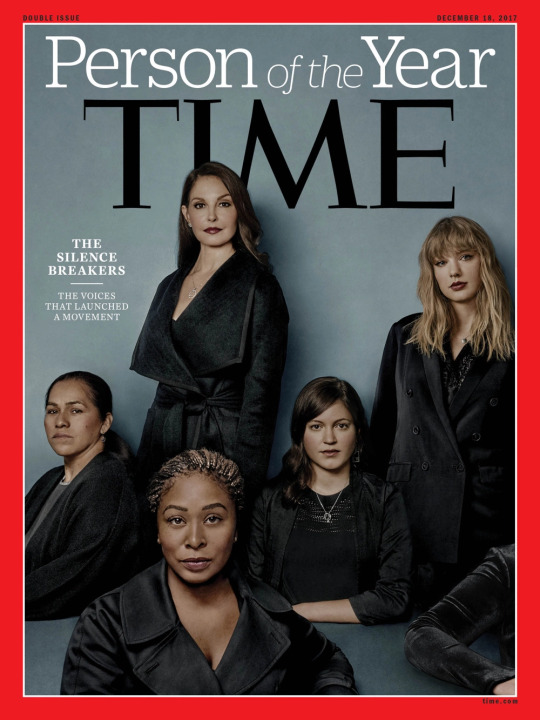
Ashley Judd

Alyssa Milano

Tarana Burke
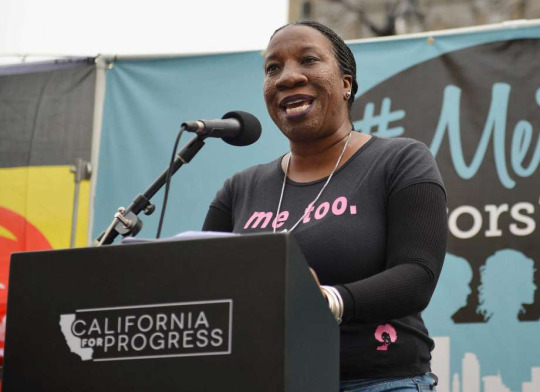
Selma Blair

Plaza Hotel Plaintiffs

And to all the other incredible women whose stood up and shared their stories. Unfortunately too many to add here. And to all the women who haven’t: we stand by you through it all.
#NeverAgain
0 notes
Text
KIND Invests $20M to #SparkEmpathy By Connecting Classrooms
The KIND Foundation, started by KIND Snacks, is putting its name into practice with Empatico, an online learning tool connecting classrooms. The free tech tool for teachers aims to match and connect classrooms around the world, with $20 million in funding from The KIND Foundation.
Introducing @EmpaticoOrg, an initiative from The KIND Foundation connecting students & classrooms around the world: https://t.co/Qbo5av2RD1 pic.twitter.com/nGkHvCYVei
— KIND Snacks (@KINDSnacks) October 17, 2017
//platform.twitter.com/widgets.js
The goal is to help the next generation explore commonalities with their peers, while teaching skills like empathy—hence its hashtag, #SparkEmpathy—and kindness to tomorrow’s leaders. Empatico’s goal is to reach at least one million students in 25 countries by 2020.
Empatico follows previous KIND-funded social impact initiatives, all inspired by early experiences of KIND founder and CEO, Daniel Lubetzky, who is founder and President of The KIND Foundation.
vimeo
“My heritage as the son of a Holocaust survivor and a Mexican immigrant have shown me what happens when people don’t develop an appreciation for difference,” Lubetzky stated.
“That’s why KIND has always strived to help people discover each other’s humanity. Empatico is the most assertive step we’ve taken to realize this mission. Our hope is that this tool expands boundaries of understanding for the next generation of leaders so that they are prepared to tackle the world’s problems together.”
If you feel good, you might be more inclined to pay it forward. That's the reasoning behind @KINDSnacks' investment. https://t.co/tM2dW3Pvmi
— Fast Co. Ideas (@FastCoIdeas) October 17, 2017
//platform.twitter.com/widgets.js
The beta version is available now at Empatico.org, a collaborative platform inviting the ed tech community, teachers and global education experts to test the tool and share feedback.
Optimally designed for eight to ten year-olds, George Khalaf, Executive Director of Empatico, said stated that “Neuroscience suggests that changing the adult mind is an uphill battle because so much of our brain has already been wired, and we have developed default assumptions about those who are different. In eight to 10-year-olds, however, biases have yet to become deeply rooted. Around this time, kids are asking questions about their place in the world. Giving them an opportunity to develop this curiosity and have positive experiences with diverse people can strongly influence how they perceive others in the future.”
What would it look like to introduce your Ss to the world without setting foot outside your classroom? https://t.co/xCJQchY2Qu #SparkEmpathy pic.twitter.com/VZ7do9T73F
— Empatico (@EmpaticoOrg) October 19, 2017
//platform.twitter.com/widgets.js
Empatico blends video conferencing technology with standards-based activities on universal topics that supplement the existing curriculum. For example, “Spark” activities are classroom lessons that last from one to three hours and match the curriculum that kids are already learning. “Community Cartographers” is a two- to three-hour social studies unit including about 30 minutes of video conferencing to encourage students to map their neighborhoods with a satellite map to see where their school fits into the broader community.
The only thing classrooms need to participate is a connected computer with a camera for video chatting—and the spirit of sparking and engaging in a conversation to explore perspectives. Empatico is currently available for students who can converse in English, but plans include other language versions.
youtube
The new corporate citizenship initiative is an on-brand extension of KIND, which has consistently lived up to its brand name since founding in 2004 with the mission of do the KIND thing for your body, your taste buds and your world.
Lubetzky launched the KIND Foundation two years ago, backed by corporate revenue and his own money from shares in the company. Last fall, KIND hosted its first social entrepreneurship summit to inspire others to put their profits where there values are and help foster a better, kinder world.
youtube
Earlier this year, the Foundation tested a social media experiment called Pop Your Bubble, challenging the public to shake up their own points of view and add diverse perspectives to their Facebook feeds in a bid to c0unter fake news and close-minded thinking.
With Empatico, KIND is partnering with Making Caring Common, an initiative of the Harvard Graduate School of Education, to implement the KIND Schools Challenge, which invited middle- and high-school students to design and implement projects to make their school communities kinder and more inclusive.
Have an idea that can make your school kinder? @MCCHarvardEd & The KIND Foundation want to hear it. Learn more: https://t.co/471wzYqSiG pic.twitter.com/lhmY0vN03I
— KIND Snacks (@KINDSnacks) October 10, 2017
//platform.twitter.com/widgets.js
“I’m frankly very alarmed by what’s happening within the United States and globally in terms of rising extremism, the inability of adults to listen to one another, increasing alienation and division,” Lubetzky told Fast Company. “It’s kind of like the United States is no longer the United States of America, but it’s like two Americas.”
As for Empatico, he added: “The concept is to create a seamless, frictionless mechanism to allow classrooms across the world to connect with one another, kind of the way Airbnb or Uber help you find a ride or a place to stay, [we want] to very efficiently help teachers be able to frequently and easily connect [their classrooms] on a global basis to help narrow those gaps and help provide kids this amazing gift of being able to discover the world out of their own classrooms.”
Lubetzky feels urgency. “It needs to scale up like crazy so that we can provide counteracting measures to the increasing alienation and division that we’re seeing in the world. It’s just one small but very important step in that direction.”
The post KIND Invests $20M to #SparkEmpathy By Connecting Classrooms appeared first on brandchannel:.
from WordPress https://glenmenlow.wordpress.com/2017/10/23/kind-invests-20m-to-sparkempathy-by-connecting-classrooms/
via IFTTT
0 notes
Text
KIND Invests $20M to #SparkEmpathy By Connecting Classrooms
The KIND Foundation, started by KIND Snacks, is putting its name into practice with Empatico, an online learning tool connecting classrooms. The free tech tool for teachers aims to match and connect classrooms around the world, with $20 million in funding from The KIND Foundation.
Introducing @EmpaticoOrg, an initiative from The KIND Foundation connecting students & classrooms around the world: https://t.co/Qbo5av2RD1 pic.twitter.com/nGkHvCYVei
— KIND Snacks (@KINDSnacks) October 17, 2017
The goal is to help the next generation explore commonalities with their peers, while teaching skills like empathy—hence its hashtag, #SparkEmpathy—and kindness to tomorrow’s leaders. Empatico’s goal is to reach at least one million students in 25 countries by 2020.
Empatico follows previous KIND-funded social impact initiatives, all inspired by early experiences of KIND founder and CEO, Daniel Lubetzky, who is founder and President of The KIND Foundation.
vimeo
“My heritage as the son of a Holocaust survivor and a Mexican immigrant have shown me what happens when people don’t develop an appreciation for difference,” Lubetzky stated.
“That’s why KIND has always strived to help people discover each other’s humanity. Empatico is the most assertive step we’ve taken to realize this mission. Our hope is that this tool expands boundaries of understanding for the next generation of leaders so that they are prepared to tackle the world’s problems together.”
If you feel good, you might be more inclined to pay it forward. That's the reasoning behind @KINDSnacks' investment. https://t.co/tM2dW3Pvmi
— Fast Co. Ideas (@FastCoIdeas) October 17, 2017
The beta version is available now at Empatico.org, a collaborative platform inviting the ed tech community, teachers and global education experts to test the tool and share feedback.
Optimally designed for eight to ten year-olds, George Khalaf, Executive Director of Empatico, said stated that “Neuroscience suggests that changing the adult mind is an uphill battle because so much of our brain has already been wired, and we have developed default assumptions about those who are different. In eight to 10-year-olds, however, biases have yet to become deeply rooted. Around this time, kids are asking questions about their place in the world. Giving them an opportunity to develop this curiosity and have positive experiences with diverse people can strongly influence how they perceive others in the future.”
What would it look like to introduce your Ss to the world without setting foot outside your classroom? https://t.co/xCJQchY2Qu #SparkEmpathy pic.twitter.com/VZ7do9T73F
— Empatico (@EmpaticoOrg) October 19, 2017
Empatico blends video conferencing technology with standards-based activities on universal topics that supplement the existing curriculum. For example, “Spark” activities are classroom lessons that last from one to three hours and match the curriculum that kids are already learning. “Community Cartographers” is a two- to three-hour social studies unit including about 30 minutes of video conferencing to encourage students to map their neighborhoods with a satellite map to see where their school fits into the broader community.
The only thing classrooms need to participate is a connected computer with a camera for video chatting—and the spirit of sparking and engaging in a conversation to explore perspectives. Empatico is currently available for students who can converse in English, but plans include other language versions.
youtube
The new corporate citizenship initiative is an on-brand extension of KIND, which has consistently lived up to its brand name since founding in 2004 with the mission of do the KIND thing for your body, your taste buds and your world.
Lubetzky launched the KIND Foundation two years ago, backed by corporate revenue and his own money from shares in the company. Last fall, KIND hosted its first social entrepreneurship summit to inspire others to put their profits where there values are and help foster a better, kinder world.
youtube
Earlier this year, the Foundation tested a social media experiment called Pop Your Bubble, challenging the public to shake up their own points of view and add diverse perspectives to their Facebook feeds in a bid to c0unter fake news and close-minded thinking.
With Empatico, KIND is partnering with Making Caring Common, an initiative of the Harvard Graduate School of Education, to implement the KIND Schools Challenge, which invited middle- and high-school students to design and implement projects to make their school communities kinder and more inclusive.
Have an idea that can make your school kinder? @MCCHarvardEd & The KIND Foundation want to hear it. Learn more: https://t.co/471wzYqSiG pic.twitter.com/lhmY0vN03I
— KIND Snacks (@KINDSnacks) October 10, 2017
“I’m frankly very alarmed by what’s happening within the United States and globally in terms of rising extremism, the inability of adults to listen to one another, increasing alienation and division,” Lubetzky told Fast Company. “It’s kind of like the United States is no longer the United States of America, but it’s like two Americas.”
As for Empatico, he added: “The concept is to create a seamless, frictionless mechanism to allow classrooms across the world to connect with one another, kind of the way Airbnb or Uber help you find a ride or a place to stay, [we want] to very efficiently help teachers be able to frequently and easily connect [their classrooms] on a global basis to help narrow those gaps and help provide kids this amazing gift of being able to discover the world out of their own classrooms.”
Lubetzky feels urgency. “It needs to scale up like crazy so that we can provide counteracting measures to the increasing alienation and division that we’re seeing in the world. It’s just one small but very important step in that direction.”
The post KIND Invests $20M to #SparkEmpathy By Connecting Classrooms appeared first on brandchannel:.
0 notes
Text
KIND Invests $20M to #SparkEmpathy By Connecting Classrooms
The KIND Foundation, started by KIND Snacks, is putting its name into practice with Empatico, an online learning tool connecting classrooms. The free tech tool for teachers aims to match and connect classrooms around the world, with $20 million in funding from The KIND Foundation.
Introducing @EmpaticoOrg, an initiative from The KIND Foundation connecting students & classrooms around the world: https://t.co/Qbo5av2RD1 http://pic.twitter.com/nGkHvCYVei
— KIND Snacks (@KINDSnacks) October 17, 2017
The goal is to help the next generation explore commonalities with their peers, while teaching skills like empathy—hence its hashtag, #SparkEmpathy—and kindness to tomorrow’s leaders. Empatico’s goal is to reach at least one million students in 25 countries by 2020.
Empatico follows previous KIND-funded social impact initiatives, all inspired by early experiences of KIND founder and CEO, Daniel Lubetzky, who is founder and President of The KIND Foundation.
vimeo
“My heritage as the son of a Holocaust survivor and a Mexican immigrant have shown me what happens when people don’t develop an appreciation for difference,” Lubetzky stated.
“That’s why KIND has always strived to help people discover each other’s humanity. Empatico is the most assertive step we’ve taken to realize this mission. Our hope is that this tool expands boundaries of understanding for the next generation of leaders so that they are prepared to tackle the world’s problems together.”
If you feel good, you might be more inclined to pay it forward. That's the reasoning behind @KINDSnacks' investment. https://t.co/tM2dW3Pvmi
— Fast Co. Ideas (@FastCoIdeas) October 17, 2017
The beta version is available now at Empatico.org, a collaborative platform inviting the ed tech community, teachers and global education experts to test the tool and share feedback.
Optimally designed for eight to ten year-olds, George Khalaf, Executive Director of Empatico, said stated that “Neuroscience suggests that changing the adult mind is an uphill battle because so much of our brain has already been wired, and we have developed default assumptions about those who are different. In eight to 10-year-olds, however, biases have yet to become deeply rooted. Around this time, kids are asking questions about their place in the world. Giving them an opportunity to develop this curiosity and have positive experiences with diverse people can strongly influence how they perceive others in the future.”
What would it look like to introduce your Ss to the world without setting foot outside your classroom? https://t.co/xCJQchY2Qu #SparkEmpathy http://pic.twitter.com/VZ7do9T73F
— Empatico (@EmpaticoOrg) October 19, 2017
Empatico blends video conferencing technology with standards-based activities on universal topics that supplement the existing curriculum. For example, “Spark” activities are classroom lessons that last from one to three hours and match the curriculum that kids are already learning. “Community Cartographers” is a two- to three-hour social studies unit including about 30 minutes of video conferencing to encourage students to map their neighborhoods with a satellite map to see where their school fits into the broader community.
The only thing classrooms need to participate is a connected computer with a camera for video chatting—and the spirit of sparking and engaging in a conversation to explore perspectives. Empatico is currently available for students who can converse in English, but plans include other language versions.
youtube
The new corporate citizenship initiative is an on-brand extension of KIND, which has consistently lived up to its brand name since founding in 2004 with the mission of do the KIND thing for your body, your taste buds and your world.
Lubetzky launched the KIND Foundation two years ago, backed by corporate revenue and his own money from shares in the company. Last fall, KIND hosted its first social entrepreneurship summit to inspire others to put their profits where there values are and help foster a better, kinder world.
youtube
Earlier this year, the Foundation tested a social media experiment called Pop Your Bubble, challenging the public to shake up their own points of view and add diverse perspectives to their Facebook feeds in a bid to c0unter fake news and close-minded thinking.
With Empatico, KIND is partnering with Making Caring Common, an initiative of the Harvard Graduate School of Education, to implement the KIND Schools Challenge, which invited middle- and high-school students to design and implement projects to make their school communities kinder and more inclusive.
Have an idea that can make your school kinder? @MCCHarvardEd & The KIND Foundation want to hear it. Learn more: https://t.co/471wzYqSiG http://pic.twitter.com/lhmY0vN03I
— KIND Snacks (@KINDSnacks) October 10, 2017
“I’m frankly very alarmed by what’s happening within the United States and globally in terms of rising extremism, the inability of adults to listen to one another, increasing alienation and division,” Lubetzky told Fast Company. “It’s kind of like the United States is no longer the United States of America, but it’s like two Americas.”
As for Empatico, he added: “The concept is to create a seamless, frictionless mechanism to allow classrooms across the world to connect with one another, kind of the way Airbnb or Uber help you find a ride or a place to stay, [we want] to very efficiently help teachers be able to frequently and easily connect [their classrooms] on a global basis to help narrow those gaps and help provide kids this amazing gift of being able to discover the world out of their own classrooms.”
Lubetzky feels urgency. “It needs to scale up like crazy so that we can provide counteracting measures to the increasing alienation and division that we’re seeing in the world. It’s just one small but very important step in that direction.”
The post KIND Invests $20M to #SparkEmpathy By Connecting Classrooms appeared first on brandchannel:.
0 notes
Text
WEEK 10 PRESENTATION



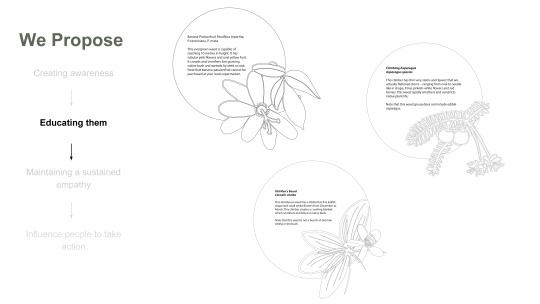
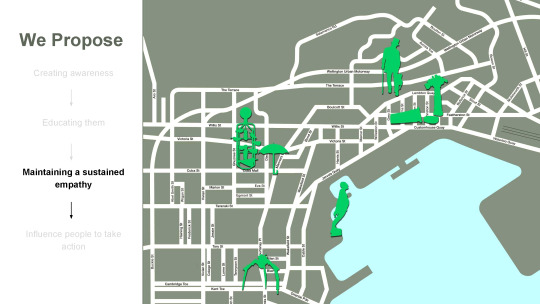


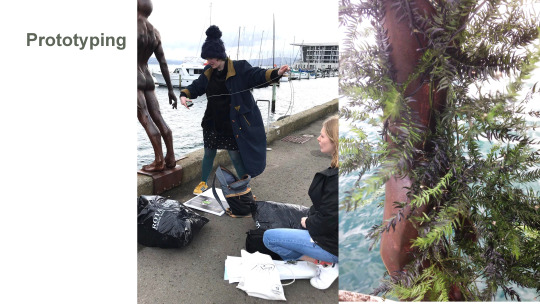
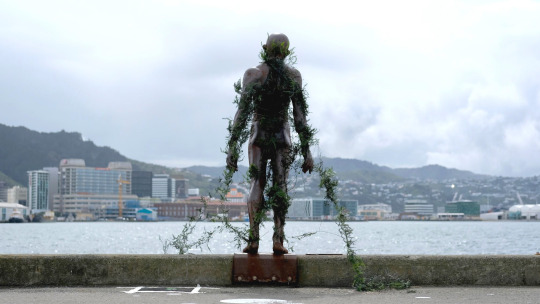
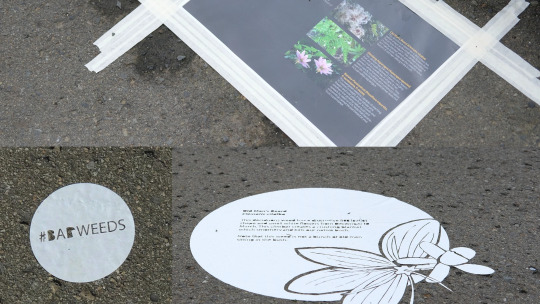




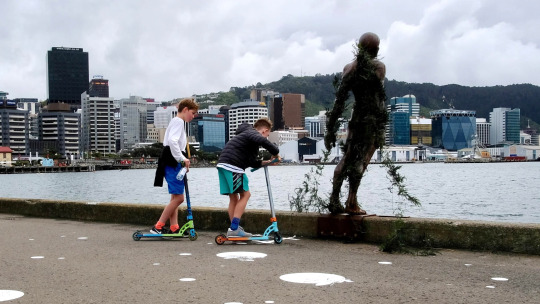

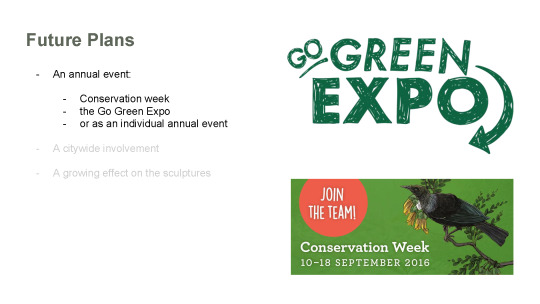

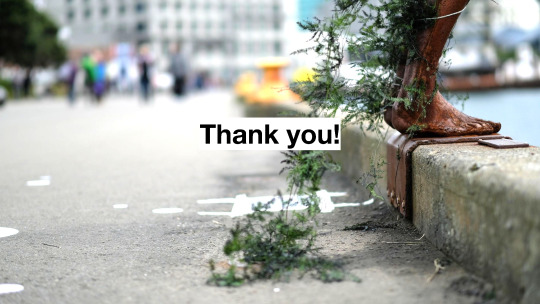
Maddy
Ting
SLIDE 1
Hi there, I’m Maddy and this is Ting. Our design initiative is called the Wellington in a Tangle, also including Kat and Phoebe; and we have been tasked by you to figure out how design can help raise awareness for the ecological weed problem in Wellington.
We are focusing, as instructed, on the climbing asparagus, old man’s beard and banana passionfruit vine like ecological weeds. They each are extremely harmful to native plant life and we found, in our own work through the production of our prototype, how difficult they are to remove.
SLIDE 2
We propose an annual an awareness campaign. This campaign involves 3 steps; creating awareness, educating the public and maintaining a sustained empathy which would all influence people to take action on behalf of the Wellington City Council.
SLIDE 3
The first step in our awareness campaign begins with an urban intervention. This urban intervention has taken the shape of an installation on the ‘Solace in the Wind’ sculpture on Wellington’s waterfront. As seen in this mock up image here we aim to incorporate the kinetic nature of the sculpture with our installation; wrapping weeds around the body and limbs. This will act as a way to catch the public’s attention and become a conversation starter.
SLIDE 4
With this urban intervention we must also provide the public with some information before they move past. Vinyl stickers are an easy, affordable way to do this. As seen here we designed 3 sticker prototypes with basic images of the weeds and some information that helped to identify them. There were also some catchy taglines at the end of each paragraph to remain in a person’s mind. For example, we provided a note that banana-passionfruit cannot be purchased at your local supermarket; just in case.
SLIDE 5
The next step involves maintaining a sustained level of empathy over a longer period. To achieve this the installation would occur on statues all around Wellington’s city centre on an annual basis, as seen in the map here. We could maintain this renewal of information by connecting these installations to annual events.
SLIDE 6
These three steps working together will provide people the information and initiative to take action themselves.
SLIDE 7
Producing the urban intervention was a process of picking the climbing asparagus from Aro Valley and painting it black to add more depth and contrast to the green weeds.
SLIDE 8
Setting up the installation at the waterfront involved wrapping rope initially around the sculpture to provide support. The asparagus was then wrapped around the ‘Solace in the Wind’ sculpture. Emulating how it would behave in nature. We are grateful that the artist, Max Patte, and the Wellington waterfront coordinator Fraser Ebbett were happy for us to do this.
SLIDE 9
The final prototype created a great initial stopping factor.
SLIDE 10
The stickers and posters provided more information for people who stopped as well as guiding them towards the sculpture. The hashtag BADWEEDS was used to highlight the topic and connect people online.
SLIDE 11
The urban intervention was very successful. Here we have some people interacting with the stickers.
SLIDE 12
Here we have an example of how the older generation has a lot more knowledge about the subject already. They knew exactly what we were talking about as we set up.
SLIDE 13
This image perfectly shows the many layers of interaction with this installation.
SLIDE 14
Here we have some more people looking at the stickers.
SLIDE 15
There were some kids who found the installation interesting. Most kids were there with their parents; who enjoyed starting that dialogue about the ecological weed problem.
SLIDE 16
Many young adults enjoyed the tactile nature of the installation; taking photos and touching it. Making it from the actual weeds proved successful here.
SLIDE 17
The future of this project involves the continued raising of awareness and education over the years. We will do this by connecting this urban intervention to an annual event in Wellington, like Conservation Week or the Go Green Expo.
SLIDE 18
The scope of the urban intervention will also grow as we spread around different sculptures in Wellington’s arty city. Where the weeds would daily increase in volume on the multiple sculptures around the city to produce an effect of vine like growth. We believe this response truly reflects the Wellington City Council’s need for awareness, education and empathy. This action has proven itself to be instantly effective and we are confident that it will provide a lasting impact over the years.
SLIDE 19 - DONE
0 notes
Text
Hot Chocolate. Something Everybody Loves.
Today my heart is heavy for a multitude of reasons. The issues I’ve been ugly crying about are important but for the purpose of this post they are not relevant. What I want to focus on here is the fact that individuals many differ these issues but we can agree on finding solutions.
Those solutions will not be found on combative and inflammatory memes, posts, and hashtags in social media. They will not be found barking party lines at our political “opponents.” And they will certainly not be found in destructive arguments between individuals whether in person or on social media. Especially not through the oft anonymous platform of the internet.
Table. Fuzzy Blankets. Hot Coffee. Steaming Bowls of Pasta and Sauce. Chocolate. Sofas.
Home.
Its in the homes that we can gently, politely and lovingly unpack these tricky, complex topics. There was a time when I would have easily spotted off the party-line about this issue or that issue and bemoaned the ignorance of the other party’s intelligence. But not anymore. Human lives are at stake. People’s soul’s are the issue. I can spew out simple answers to extremely complex and complicated problems. Problems that I will probably never face but so many countless others will bear the weight of every day, and for some may even see their own existence snuffed out by the outcomes of these policies so cavalierly applied.
But at home...
glasses filled with delicious beverages, hot or cold. Cold feet tucked in with blankets and pillows pilled around. The dinning table crowded around with warm words, laughter, encouragement, and ideas. Good ideas.
Its in our homes that we can open doors to people we don’t see eye to eye with and have open and honest dialogue. Over a meal we can share the common themes and values that crisscross our lives and unite us in our faith. Sipping coffee on our sofas we can sit and listen to the stories that our neighbors and friends have kept inside of them that directs their thoughts and decisions. We can better understand our little sphere of influence and how we can actually do things, basic and simple things that are generate lasting, positive, life-giving change. First in our homes. Then our churches, our neighborhoods, and our communities.
But first. We have to be willing to open our front doors and allow others inside.
Don’t misunderstand me. Its not about the food, or drinks, or the house, the fuzzy blankets. But its what those places and things represent: intimacy, vulnerability, courage, empathy, curiosity, compassion, joy, friendship, hospitality, encouragement, forgiveness. CHRIST-likeness.
Its not in making a gourmet meal, or sharing great coffee that we change the world. But it might be over a meal or cup of coffee that we are able to have open and genuine discusses about those things that are heavy on our hearts. Food and drink are optional but honesty and mutual courtesy are not.
0 notes